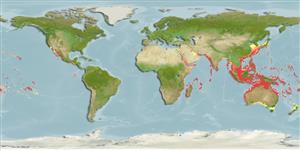Common names from other countries
Environment: milieu / climate zone / depth range / distribution range
Écologie
; profondeur 1 - 150 m (Ref. 96667). Tropical; 42°N - 49°S, 26°E - 89°W
Distribution
Pays | Zones FAO | Écosystèmes | Occurrences | Introductions
Indo-Pacific: Red Sea to Hawaii; Cocos Islands to Australia, French Polynesia and Hawaii.
Length at first maturity / Taille / Poids / Âge
Maturity: Lm ? range ? - ? cm Max length : 8.0 cm CW mâle / non sexé; (Ref. 343)
Found on sandy shelly substrates, often in reefs and among seagrass beds (Ref. 343). A predatory carnivore: a specialized malacophage, with chela designed for crushing (Ref. 97241).
Life cycle and mating behavior
Maturité | Reproduction | Frai | Œufs | Fécondité | Larves
Members of the order Decapoda are mostly gonochoric. Mating behavior: Precopulatory courtship ritual is common (through olfactory and tactile cues); usually indirect sperm transfer.
Ng, P.K.L. 1998. (Ref. 343)
Statut dans la liste rouge de l'IUCN (Ref. 130435)
statut CITES (Ref. 108899)
Not Evaluated
Not Evaluated
Utilisations par l'homme
Pêcheries: commercial
| FishSource | Sea Around Us
Outils
Plus d'informations
Taille/Âge
Croissance
Longueur-poids
Longueur-longueur
Morphologie
Larves
Abondance
Sources Internet
Estimates based on models
Preferred temperature
(Ref.
115969): 22.9 - 29, mean 27.9 (based on 2018 cells).
Vulnérabilité
Low vulnerability (10 of 100).
Catégorie de prix
Unknown.
